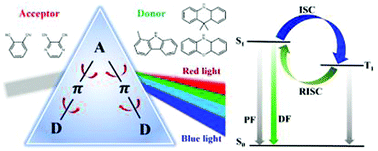Theoretical studies on full-color thermally activated delayed fluorescence molecules†
Abstract
Thermally activated delayed fluorescence (TADF) materials have attracted wide attention due to the full utilization of triplet and singlet excitons. Beyond the typical donor–acceptor (D–A) TADF compounds, D–π–A–π–D TADF emitters were reported recently. In this paper, we study the dynamic nature of excited states of four D–π–A–π–D TADF molecules with full color emission at the first principles level. It shows that MAC-PN has good TADF efficiency benefiting from the large reverse intersystem crossing (RISC, krisc) and radiative decay (kr) rates. PX-PN and MCZ-DPPN molecules have a reduced TADF efficiency, owing to the largely increased non-radiative decay rate (knr) by two orders of magnitude and decreased krisc, respectively, while PX-CNP shows the worst TADF performance, because knr is five orders of magnitude larger than kr. Moreover, reorganization energy analysis reveals that the RISC process is largely manipulated by the torsional vibration of the dihedral angle, while the non-radiative process mainly happens through the channels of bond stretching vibration. These calculations agree well with the experimental efficiency trend among the four TADF molecules and uncover the intrinsic TADF mechanisms, providing the possibility of further engineering the molecules with improved TADF efficiency.



 Please wait while we load your content...
Please wait while we load your content...